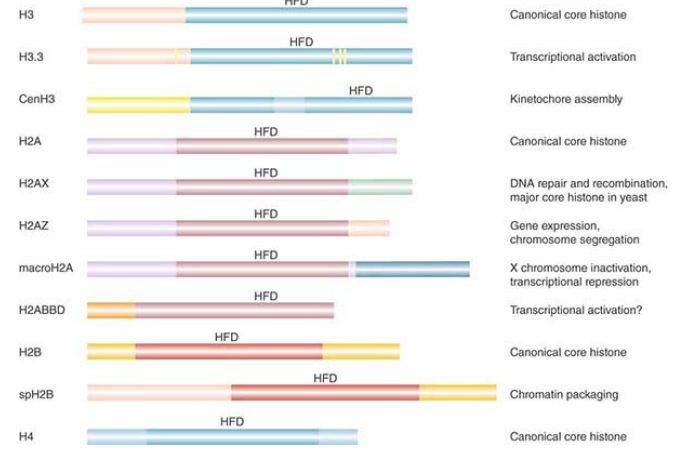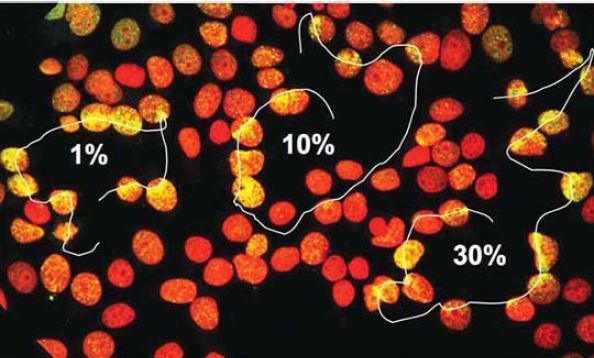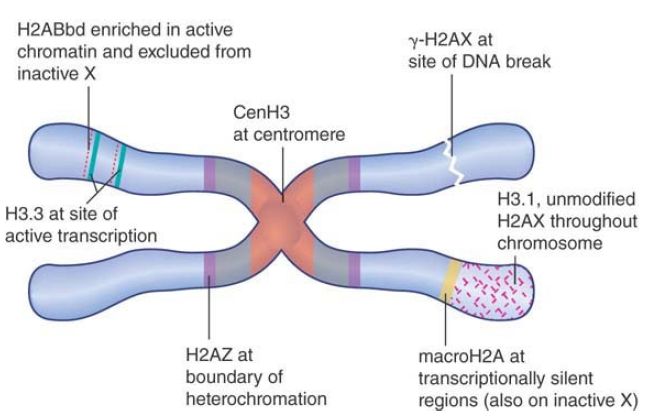
Histone Variants Produce Alternative Nucleosomes
 المؤلف:
JOCELYN E. KREBS, ELLIOTT S. GOLDSTEIN and STEPHEN T. KILPATRICK
المؤلف:
JOCELYN E. KREBS, ELLIOTT S. GOLDSTEIN and STEPHEN T. KILPATRICK
 المصدر:
LEWIN’S GENES XII
المصدر:
LEWIN’S GENES XII
 الجزء والصفحة:
الجزء والصفحة:
 25-3-2021
25-3-2021
 3526
3526
Histone Variants Produce Alternative Nucleosomes
KEY CONCEPTS
-All core histones except H4 are members of families of related variants.
-Histone variants can be closely related to or highly divergent from canonical histones.
-Different variants serve different functions in the cell.
Whereas all nucleosomes share a related core structure, some nucleosomes exhibit subtle or dramatic differences resulting from the incorporation of histone variants. Histone variants comprise a large group of histones that are related to the histones we have already discussed, but have differences in sequence from the “canonical” histones. These sequence differences can be small (as few as four amino acid differences) or extensive (such as alternative tail sequences).
Variants have been identified for all core histones except histone H4. FIGURE 1 summarizes the best characterized histone variants. Most variants have significant differences between them, particularly in the N- and C-terminal tails. At one extreme, macroH2A is nearly three times larger than conventional H2A and contains a large C-terminal tail that is not related to any other histone. At the other end of the spectrum, canonical H3 (also known as H3.1) differs from the H3.3 variant at only four amino acid positions—three in the histone core and one in the N-terminal tail.

FIGURE 1 The major core histones contain a conserved histone-fold domain. In the histone H3.3 variant, the residues that differ from the major histone H3 (also known as H3.1) are highlighted in yellow. The centromeric histone CenH3 has a unique N terminus, which does not resemble other core histones. Most H2A variants contain alternative C-termini, except H2ABbd, which contains a distinct N terminus. The sperm-specific SpH2B has a long N-terminus. Proposed functions of the variants are listed.
Data from: Sarma, K., and Reinberg, D. 2005. Nat Rev Mol Cell Biol 6:139–149.
Histone variants have been implicated in a number of different functions, and their incorporation changes the nature of the chromatin containing the variant. We have previously discussed one type of histone variant, the centromeric H3 (or CenH3) histone, known as Cse4 in yeast. CenH3 histones are incorporated into specialized nucleosomes present at centromeres in all eukaryotes . There remains a spirited debate over the structure and composition of centromeric nucleosomes. In one model, CenH3 nucleosomes contain a normal octameric histone core, containing two copies of the CenH3.
However, compelling evidence in budding yeast supports an alternative model in which centromeric nucleosomes consist of “hemisomes” containing one copy each of Cse4, H4, H2A, and H2B. Whether one or both models are correct will likely involve further investigation.
The other major H3 variant is histone H3.3. In multicellular eukaryotes, this variant is a minority component of the total H3 in the cell, but in yeast, the major H3 is actually of the H3.3 type. H3.3 is expressed throughout the cell cycle, in contrast to most histones that are expressed during S phase, when new chromatin assembly is required during DNA replication. As a result, H3.3 is available for assembly at any time in the cell cycle and is incorporated at sites of active transcription, where nucleosomes become disrupted. For this reason, H3.3 is often referred to as a “replacement” histone, in contrast to the “replicative” histone H3.1 .
The H2A variants are the largest and most diverse family of core histone variants, and have been implicated in a variety of distinct functions. One that has been extensively studied is the variant H2AX. The H2AX variant is normally present in only 10%–15% of the nucleosomes in multicellular eukaryotes, though again (like H3.3) this subtype is the major H2A present in yeast. It has a Cterminal tail that is distinct from the canonical H2A, characterized by a SQEL/Y motif at the end. This motif is the target of phosphorylation by ATM/ATR kinases, activated by DNA damage, and this histone variant is involved in DNA repair, particularly repairof double-strand breaks (see the chapter titled Repair Systems).
H2AX phosphorylated at the SQEL/Y motif is sometimes referred to as “γ-H2AX” and is required to stabilize binding of various repairfactors at DNA breaks and to maintain checkpoint arrest. γ-H2AX appears within moments at broken DNA ends, as demonstrated in FIGURE 2, which shows a cartoon of foci of γ-H2AX formingalong the path of double-strand breaks induced by a laser.

FIGURE 2. γ-H2AX is detected by an antibody (yellow) and appears along the path traced by a laser that produces doublestrand breaks (white line).
© Rogakou et al., 1999. Originally published in The Journal of Cell Biology, 146: 905-915.
Photo courtesy of William M. Bonner, National Cancer Institute, NIH.
Other H2A variants have different roles. Researchers have shown the H2AZ variant, which has ~60% sequence identity with canonical H2A, to be important in several processes, such as gene activation, heterochromatin–euchromatin boundary formation, cell-cycle progression, and it can be enriched at the centromere, at least in some species. The vertebrate-specific macroH2A is named for its extremely long C-terminal tail, which contains a leucine-zipper dimerization motif that might mediate chromatin compaction by facilitating internucleosome interactions. Mammalian macroH2A is enriched in the inactive X chromosome in females, which is assembled into a silent, heterochromatic state. In contrast, the mammalian H2ABbd variant is excluded from the inactive X and forms a less stable nucleosome than canonical H2A; perhaps this histone is designed to be more easily displaced in transcriptionally active regions of euchromatin.
Still other variants are expressed in limited tissues, such as spH2B, which is present in sperm and required for chromatin compaction. The presence and distribution of histone variants shows that individual chromatin regions, entire chromosomes, or even specific tissues can have unique “flavors” of chromatin specialized for different functions. FIGURE 3 is a schematic illustrating some typical distribution patterns of some of the better characterized histone variants. In addition, the histone variants, like the canonical histones, are subject to numerous covalent modifications, adding levels of complexity to the roles chromatin plays in nuclear processes.

FIGURE 3 Some histone variants are spread throughout all or most of the chromosome, whereas others show specific distribution patterns. Characteristic patterns are shown for several histone variants on a cartoon autosome. Note that histone variant distributions can be dramatically different on dosage-compensated sex chromosomes (like the mammalian inactive X), in sperm chromatin, or other highly specialized chromatin states.
 الاكثر قراءة في مواضيع عامة في الاحياء الجزيئي
الاكثر قراءة في مواضيع عامة في الاحياء الجزيئي
 اخر الاخبار
اخر الاخبار
اخبار العتبة العباسية المقدسة


